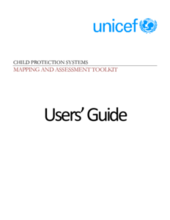The Child Protection System Mapping and Assessment Toolkit directly responds to the Child Protection Strategy to "develop and apply an analytic tool for mapping and assessing existing child protection policies, laws and services for adequacy and to identify obstacles and opportunities in implementation, especially in reaching vulnerable or excluded groups".
Its content draws form an extensive array of materials representing the latest thinking in child protection from around the world. It benefits from testing in seven countries - Bangladesh, Cambodia, Democratic Republic of Congo, Guatemala, Kenya, Kyrgyzstan, and Tunisia - and input from a reference group of practitioners and academics from various child protection perspectives.
There are two parts to the toolkit: The first is a Comprehensive Toolkit that allows countries to undertake a thorough mapping of their child protection systems, and to obtain a clearer picture of the strengths and gaps in those systems. The second is a Core Toolkit that provides for a more concise mapping and assessment of a country, focusing on key elements of the system. This version is particularly appropriate for countries with very liminted capacity or difficult emergency contexts. Both versions are fully consistent with one another, and each can be customized to the country's context. The Users' Guide applies to both. The kits contain a number of inter-related tools organised into five sections:
(1) General Country Information, which establishes a context within the system operates including the global legal and policy frameworks, the policy and legislative framework, and the specific risks that children face within a country;
(2) System Overview, including system structures, functions, capacities, and the children and justice sector, with tools assessing the community context and role of civil society;
(3) Continuum of Care, which assesses the protective environment, including norms and attitudes;
(4) Resource Mobilization and Fiscal Accountability, which assesses the human and financial needs of the system and how well child protection is reflected during the budget process, and
(5) Moving Forward on System Development, which allows users to frame and cost a program to develop the child protection system drawing on the results of the mapping and assessment.
The ultimate objective is to support the development of comprehensive effective and efficient child protection systems, appropriately structured and resourced, to reach and cater to children and their families. The Toolkit is intended to help users to identify and prioritize actions which will contribute to this process.

